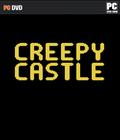Just by looking at a few screenshots, you know what to expect from a game that claims retro sensibilities. Details aside, you'll immediately know if you're looking at an RPG, side-scrolling run-and-gun title, or a platformer that aims to ape one of the many from the heyday of the cartridge. Creepy Castle is a bit different because it may look like a side-scrolling platformer that came from the era of the ZX Spectrum, but it plays like something else entirely.
You play the role of a moth who happens to be named Moth. An adventurer and explorer by trade, you make your way to a place known to many as the Creepy Castle to seek some unknown truth. What you find instead is a group of scientists led by someone known as Darking, and they're developing a weapon to dominate the world. You're there to stop them, but you also discover that a faction within that organization is plotting against Darking, so you wonder what's really going on.
Though it isn't the deepest tale, it's interesting to see a deeper-than-usual narrative for a platformer. Except for Darking, all of the enemies look cute in their own way, and there is loads of humor in the title, giving the false impression that it's meant for kids. Those who adore lore will be in love with this game, since you'll learn about the history of some of the characters and learn about living conditions via diaries found in the world. Even the landmarks that act as tutorials give you some insight into the characters that write them, and most end with catchphrases and are accompanied by humorous sketches and dialogue that make even the most basic things sound more exciting or important.
The platforming elements are pretty simple. You can walk left or right and climb or descend ladders and stairs. There are treasure chests to open, doors to unlock, and save points to maintain progression. There's also a basic inventory system that you can access in real time, and you'll have to actively avoid traps. It doesn't take long to notice that some basic platforming elements are missing. You can survive very long falls, but you can't jump at all. You can't freely attack anyone, and none of your foes bother moving from their designated spots.
Get close enough to an enemy, and you'll notice an attack command pop up, a sign that the game is less of a platformer and more of an RPG. Even then, the shift into the genre is pretty light. Battles are turn-based, and your only command is to punch. You can use healing and attack items or special attack moves. Every thrown punch ends with you being counterpunched unless the enemy dies first. Since no animations are shown, the only indicators you have about how the fight is going are the energy meters — for yourself and your opponent — and the enemy death animation, which has them exploding into stars. It's basic but works effectively, similar to the old Ys games.
Having said that, only a few enemies will let you get away with a simple punching contest. Most will engage in some sort of minigame, none of which are very complicated but require some different mechanics. One of the more common ones requires quick reflexes, so you'll have to hit the attack button once the on-screen command appears. The other common one has you filling up a bar by constantly mashing left and right to escape from an enemy's clutches. Other minigames include avoiding a barrage of attacks, connecting pipes so energy can reach the goal, quickly hitting buttons in sequence to push someone out of an arena, and deflecting blows by highlighting a cursor. In all cases, completing them quickly or flawlessly gives you a free hit with no consequence, finishing them in average time means you both trade blows, and failing means you lose health with nothing to show for it.
The minigames in lieu of a typical battle system are going to be a sticking point for some players. The seemingly random nature of the minigames can be a deterrent to unsuspecting players. The lack of any real strategy to the fighting doesn't help either, especially since bosses can wield attacks that can't be countered. One would hesitate to call the whole thing a game of chance, but some battles can feel that way.
If you can accept the combat system, you'll find that Creepy Castle is charming. Part of that is because it only takes bits and pieces of other genres to make the experience feel both familiar yet new. Aside from the aforementioned RPG and platforming bits mixed in with some WarioWare-style minigames, there's an exploration aspect that makes the title feel like a Metroidvania game — except for the ability to completely backtrack and explore the world. While you can't explore every nook and cranny, you can play as a completely different character with a new storyline once you progress far enough, making up for that lost depth and giving you better insight to the entire world.
The presentation is mixed, but that shouldn't be taken as a negative statement. The sound effects are completely retro, but the soundtrack is more akin to modern chiptune than something from the era it's trying to emulate. Much like the tunes used for Shovel Knight and Scott Pilgrim vs. The World, each of the tracks is catchy and perfect for the game.
On the graphics side, the game apes the Spectrum ZX style with a very limited color palette. It even tries to fake transparency by surrounding rounded objects with black sprites. There are a few color styles you can choose from, but it doesn't quite meet the Sega Master System or NES standards. While you don't have any options for actual resolution change, it scales well enough, so the full screen looks fine and adheres to a standard 4:3 ratio. There are a ton of graphical filters that can be used, from increased color bloom to CRT scanlines, and you can even change the scrolling from smooth to very choppy; gamers who grew up using the UK computer might value this nostalgic touch.
Once you come to grips with what Creepy Castle is, you'll fall in love with it. The retro style is done well, warts and all, but it still manages to pull off a look that makes it stand out in a sea of other retro-themed titles. Gameplay is quirky enough that some may not appreciate it, but the various minigames give it lots of life. Most of all, the title oozes enough charm to make you keep playing even after you've lost a few times. For those who want something that's well-crafted but a bit off the wall, Creepy Castle is it.
Score: 8.5/10
More articles about Creepy Castle











 Creepy Castle is a side-scrolling RPG adventure that follows the journey of a plucky adventurer, Moth (who, yes, happens to be a moth), as he investigates a conspiracy welling deep within the stone walls of an ancient castle.
Creepy Castle is a side-scrolling RPG adventure that follows the journey of a plucky adventurer, Moth (who, yes, happens to be a moth), as he investigates a conspiracy welling deep within the stone walls of an ancient castle.








